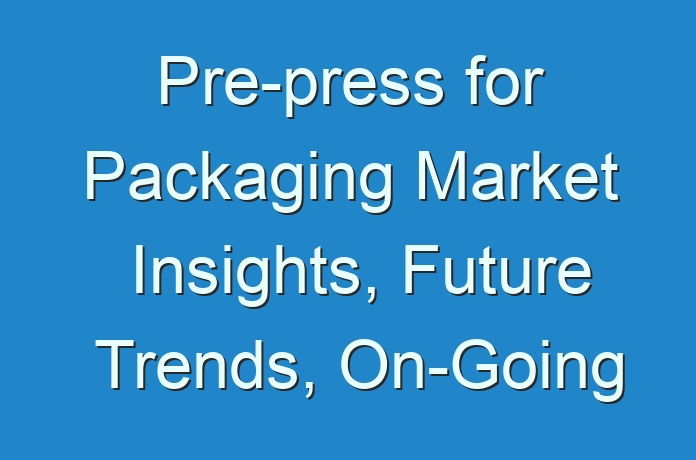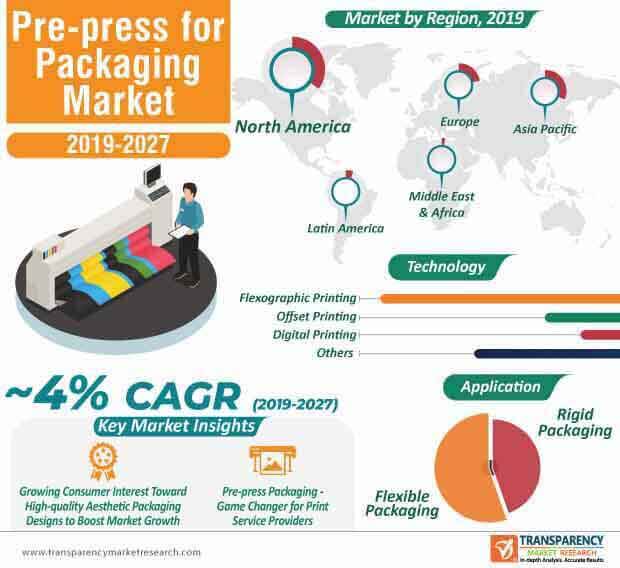
Pre-press for Packaging Market: Technologically-advanced Solutions Set to Replace Conventional Printing Techniques
The printing sector has consistently witnessed a series of periodic changes. As technology continues to evolve, new printing techniques have entered the fray, and have increased the demand for computer-generated layouts in the printing and pre-press for packaging market. As per observable trends in the pre-press for packaging market space, the industry has gradually swayed toward digital printing alternatives – leaving behind conventional offset printing techniques. The role of packaging has evolved with time, and today, it is a major parameter that could impact the sales of a company. Over the past decade, consumer interests toward packaging has increased at an exponential rate, which, in turn, has compelled brands to focus on the aesthetic aspects of their packaging designs. Growing consumer affinity toward innovative and attractive packaging, coupled with advances in flexographic and digital printing, are some of the leading factors that are expected to drive the growth of the pre-press for packaging market close to the US$ 5 billion figure by the end of the forecast period (2019-2027).

Request a sample to get extensive insights into the Pre-press for Packaging Market https://www.transparencymarketresearch.com/sample/sample.php?flag=S&rep_id=26933
Brands Turn to Flexographic Printing to Improve Packaging Graphics
During the last few years, flexographic printing has garnered significant popularity. As more and more companies align their packaging offerings in tune with evolving consumer preferences, flexographic printing has emerged as an ideal printing alternative. Companies operating in the pre-press for packaging market are leveraging the benefits of flexographic printing to solidify their foothold in the market. The adoption of flexographic printing is on the rise, and by the end of 2027, this segment is projected to attain a value of ~US$ 3.6 billion, and account for over 70% of the total pre-press for packaging market share in terms of value.
The flexographic printing technique offers brands the flexibility of printing on an array of materials, including cellophane, metallic films, plastic, and paper, among others. Further, this technique is increasingly being used to print large areas of solid color, particularly on packages in the food & beverage sector. Further, as flexographic printing allows high definition printing on roll stock or polybags, it improves clarity of the graphics on packages by a significant margin – a leading factor influencing its demand. Companies are leveraging the benefits offered by flexographic printing to formulate impactful and eye-catching branding and marketing strategies.
Brands Turn to Digital Printing to Meet High Demand for Customized Packaging
Despite the dawn of the digital era, several companies within the packaging sector are yet to recognize the true potential of digital printing, and thus, are reluctant to move away from conventional printing techniques. However, with advances in digital printing, the adoption rate has started to move in the upward trajectory, as brands can provide high-quality designs at economical prices. Despite the dominance of flexographic printing in the pre-press for the packaging market, the digital printing segment is expected to witness the highest growth at a CAGR of around 4.4% over the stipulated timeframe of the study. The growth can be attributed to the benefits offered by digital printing techniques over conventional alternatives. Digital printing allows brands to cater to evolving consumer preferences with greater efficiency and at a faster rate, which thereby improves the supply chain and reduces warehouse costs.
To understand how our report can bring difference to your business strategy, Ask for a brochure https://www.transparencymarketresearch.com/sample/sample.php?flag=B&rep_id=26933
As digital printing is cost-effective, quicker, and allows brands more flexibility as compared to traditional techniques, its adoption is expected to witness steady growth over the next few years. Mounting consumer interest toward customized packaging is a trend that is expected to present market players operating in the pre-press for packaging market a range of lucrative opportunities. Further, with the growing demand for customization, offset printing techniques are expected to become less valuable.
Pre-press for Packaging Market Players to Focus on New Product Launches
The onset of innovative technologies, globalization, and rapidly evolving consumer interests are prompting players operating in the pre-press for the packaging sector to introduce innovative solutions that focus on customization and sustainability. Several companies are launching new packaging solutions to cater to fluctuating consumer demands. For instance, in October 2019, Comexi announced the launch of a new solution that offers improved color stability and matching. The newly launched iCIP3 software accurately matches the pre-press color data with the press and the computer-to-plate (CTP), which leads to a coordinated color-matching procedure.
Global Pre-press for Packaging Market: Overview
- According to Transparency Market Research’s latest market report on the pre-press for packaging market for the historical period of 2014-2018 and forecast period of 2019-2027, the demand for printing and packaging is anticipated to boost the demand for pre-press for packaging services.
- Globally, the pre-press for packaging market was valued at ~US$ 3.5 Bn in 2018 and is anticipated to witness a CAGR of ~4% during the forecast period.
Digital Printing to Transform Pre-press for Packaging Market
- The role of pre-press for packaging services has drastically changed over the last decade. Pre-press became a game-changer for print service providers, enabling end users to deliver the highest level of satisfaction to customers while maintaining good profitability.
- Conventionally, pre-press for packaging comprised of several time-consuming steps, and was often prone to errors, as it is a highly technical process involving a lot of manual operations.
- However, after the advent of digital printing, market dynamics promptly shifted from plates to printing technologies such as offset and flexography. Modern pre-press for packaging solutions offer better quality with flawless images and are beneficial in the long run, despite the high installation costs involved.
- The automated pre-press for packaging workflow incorporates a wide set of tools intended to help users boost their efficiency, lower costs, and minimize the impact of human errors.
- Esko’s, a pre-press for packaging service provider, has an automation engine that operates through all production steps such as screening, trapping, imposition, color management, proofreading. However, it differs from conventional software, as it features several functions that correspond to the complexity of end products such as folding cartons and corrugated boxes.





